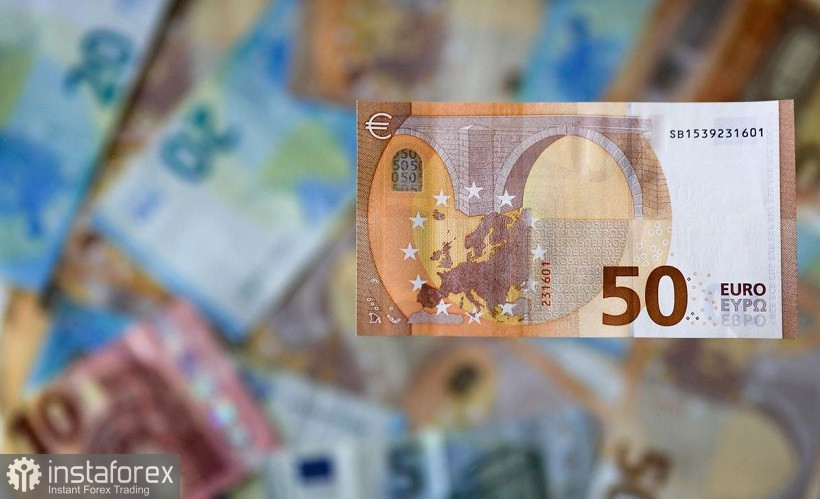At the start of a new trading week, dollar bulls again reminded of themselves: the greenback strengthened its position throughout the market, updating price records. Thus, for the first time in 20 years, the EUR/USD pair fell to the area of the 98th figure, having carried out reconnaissance in force. Having been marked at 0.9879, sellers retreated, but the mood for the pair still remains bearish.
Other dollar pairs of the "major group" demonstrate similar dynamics, reflecting the increased demand for the US currency. The US dollar index today reached the 110th mark—again, for the first time in the last 20 years. In other words, the picture emerges in a very unambiguous way: dollar bulls have organized another rally, playing out the events of the past two weeks.
Note that the EUR/USD currency pair today updated a 20-year low not only due to the strengthening of the greenback, but also due to the weakening of the euro. Firstly, macroeconomic reports were published in Europe, which for the most part ended up in the "red zone." Secondly, at the start of a new week, gas prices increased again on European stock exchanges after a significant decline on Friday. The combination of these factors put pressure on the euro, which once again reminded of its vulnerability.

For example, retail sales in the European region decreased by 0.9% in July (in annual terms). Experts expected a more modest decline (by 0.7%). In the previous month, this indicator also came out in the negative area (-3.2%). Another indicator was also disappointing—the index of investor confidence in the eurozone economy, calculated by Sentix. It collapsed in September to -31 points, although it showed signs of recovery in August. The final estimates of the PMI indices for August were also revised downwards. In particular, the German index of business activity in the services sector dropped to 47.7 points, and the composite PMI index to 46.9 points. Pan-European indices were similarly revised downwards.
But, perhaps, the main driver of the weakening of the euro was the aggravated energy crisis in the European region. Recall that at the end of last week, the cost of gas decreased significantly—for the first time in 2 weeks, a thousand cubic meters of blue fuel was estimated at less than two thousand dollars. Reuters on Friday distributed unofficial information (citing its sources) that the pipeline will resume its work until Monday. In addition, gas became cheaper due to the fact that the EU countries filled the storage facilities ahead of schedule by an average of 80% (although such an indicator was planned only by November).
However, at the opening of today's trading, the price rose sharply by 35% at once, exceeding the mark of $3,000 (with a subsequent rollback to $ 2,700). This happened against the background of a complete shutdown of gas supplies by Nord Stream-1. It turned out that Gazprom had not resumed the operation of the gas pipeline—it was stopped indefinitely, until the malfunction of the only working engine was eliminated. In addition, Dmitry Peskov, press secretary of the President of Russia, said that anti-Russian sanctions do not allow Gazprom to fully supply fuel to Europe.
It is obvious that the worsening energy crisis will drag inflation, which has already reached 9% in the eurozone. The euro was again under strong pressure, allowing the EUR/USD bears to completely control the situation on the pair.
The dollar, in turn, is getting more expensive amid increasing hawkish expectations. The contradictory Nonfarm Payrolls report published last Friday did not break the hawkish mood of investors. According to the CME FedWatch Tool, the probability of a third consecutive rate hike by 75 basis points at the next Fed meeting in September is estimated at almost 60%. Before the publication of Nonfarms, the chances were even higher (75%) – but in my opinion, such a downward correction does not matter significantly.
Fed Chairman Jerome Powell warned at the end of August that the process of tightening the Fed's monetary policy would affect the dynamics of the US labor market, but this "side effect" would not prevent the regulator from resisting high inflation. In other words, the scenario of a 75-point rate hike at the September meeting is still the basic one, and this fact supports the greenback.
Thus, hawkish expectations regarding the further actions of the Fed, as well as general concern about the European gas crisis (here the dollar is in high demand as a defensive asset), allow EUR/USD sellers to significantly strengthen their positions.
It is noteworthy that the euro failed to organize a defense, even against the backdrop of hawkish rumors that hover around the ECB. At the end of August, Reuters published an insider that many representatives of the European regulator are ready to support a 75-point rate hike at the September meeting. Later, this information was confirmed by the heads of the Central Bank of the Netherlands, Germany and Estonia. However, this circumstance did not save EUR/USD from falling.
All this suggests that bearish sentiments still prevail for the pair. It is advisable to enter sales on corrective upward pullbacks (to the area of 1.0020-1.0050). In this case, the downward targets will be at 1.0000, 0.9950, 0.9900. It is still risky to open short positions at the bottom of the 99th figure: as a result of today's offensive, the bears failed to gain a foothold below the target of 0.9900, which indicates that the main support level is located in this price area.
 English
English 
 Русский
Русский Bahasa Indonesia
Bahasa Indonesia Bahasa Malay
Bahasa Malay ไทย
ไทย Español
Español Deutsch
Deutsch Български
Български Français
Français Tiếng Việt
Tiếng Việt 中文
中文 বাংলা
বাংলা हिन्दी
हिन्दी Čeština
Čeština Українська
Українська Română
Română

